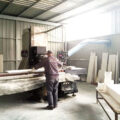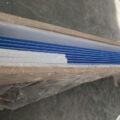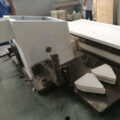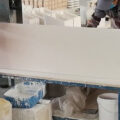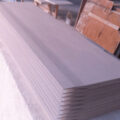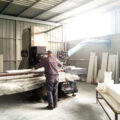Casting molten metal by continuous rolling is well known to those skilled in the art. Using roller casters, molten aluminum is effectively rolled into a plate, strip, or sheet product. A typical roll casting machine includes a pair of water-cooled rolls that rotate in opposite directions with a tiny gap or space between them. When molten aluminum is fed into the nip from the feeding tip and nozzle, it rapidly solidifies between or near the rolls to form a sheet product. The width of the sheet product is ultimately limited by the size of the roll gap.
However, the width of the casting is further controlled by the width of the outlet of the caster tip and nozzle. For example, even if the exit position is close to a wider roll gap, a feed head with an exit width of 1 meter (39 inches) can only cast sheet products of approximately the same width.
In many cases, it is desirable to produce sheet products of various widths from the same casting of molten aluminum or aluminum alloy. The feed nozzle of a conventional roll casting machine is made of multiple segments connected together and sealed at both ends to produce sheet products of a specific width.
After casting a sheet product of the first width, the currently known technology requires stopping the flow of molten metal to the casting machine, replacing the other with one feeding tip and restarting the casting operation. Such a casting interruption is expensive in terms of lost production time and labor hours spent on assembling and installing feed heads with various outlet widths. Repeated interruptions also increase the risk of damage to the casting and rolling equipment due to undetected frozen metal deposits.
AdTech provides feeding tip and nozzle for a roll casting machine, which includes a top member, a bottom member, and a pair of fixed side members between the top member and the bottom member to define a molten metal channel. The inlet and outlet of the roll casting machine, the outlet has an adjustable width, and a device for adjusting the width of the outlet during casting.
The adjustment device includes at least one spacer adapted to slidably extend through the entrance of the channel and to the exit of the channel, the spacer extending near the side member. The adjustment device includes a plurality of spacers adapted to pass through the entrance of the channel and extend to the exit of the channel, the spacers either extend to each other near the side members or are defined by a plurality of guides extending between the tops The channel extends. The bottom member is located in the middle of the side members.


